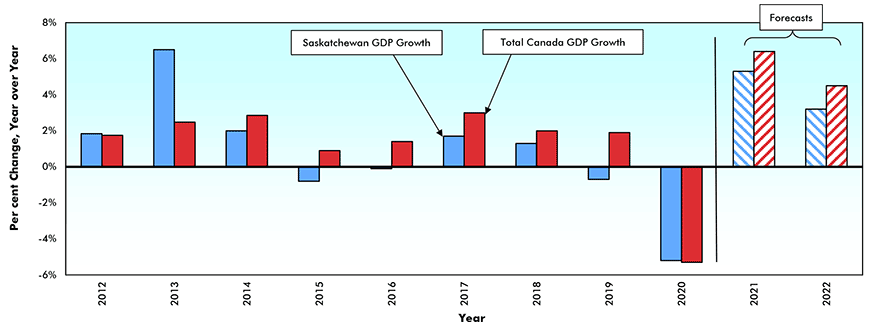Saskatchewan’s total COVID-19 case count per thousand population though mid-August is higher than for the country’s other nine provinces. However, with just over half (55%) of its population fully vaccinated, the province appears to be well-positioned to withstand the potential impact of a COVID-19 Delta variant fourth wave. This prospect is reinforced by the fact that more than 70% of the province’s population aged 50 years and over is fully vaccinated and almost three-quarters of the population aged 12 and over has had at least one dose.
Petroleum and agricultural products fuelling exports
Driven by surging growth in the U.S. and China, the market for 62% of its foreign sales, Saskatchewan’s merchandise exports from January to May of this year rose by +21.9% compared to the first five months of COVID-depressed 2020 and by +12.6% over the first five months of COVID-free 2019. Exports to the U.S. were fuelled (pun intended) primarily by a +55% jump in the value of petroleum shipments, plus strong gains in shipments of canola (+43%) and oriented strand board (+224%).
Greater exports to China were primarily the result of gains in shipments of barley (+183%YTD), meslin (a mixture of wheat and rye; +134%) and canola (+58%). Recent drought conditions in southern Saskatchewan pose a significant risk to that region’s fall crop and a lack of moisture will likely depress crop yields in the rest of the province. Stronger global growth and an upbeat outlook for agricultural commodities bode well for the future demand of potash, the province’s major mineral export, and for a potential construction ‘start’ on the Albany Potash Mine Project located southeast of Regina.
More jabs and jobs driving consumer spending and residential construction
Given the rising level of vaccine penetration, the steady decline in the COVID-19 case count since early May, and the above-mentioned rise in exports, it is not surprising that both consumer and business confidence have materially improved over the past few months. Since January, total employment has increased by 7,100 jobs, well ahead of the anemic pattern of hiring which characterized the first seven months of the five pre-pandemic years.
The combination of stronger jobs growth together with the stimulus of ultra-low interest rates, high savings rates, and a recently reported increase in have driven retail sales up by +19% year to date, well ahead of the cumulative increase (+2%) during the first five months of 2019. The major contributors to the year-to-date strength in sales have been motor vehicles, +36%, and building materials and garden equipment, +42%. Together, those two categories have accounted for over half of the overall rise in total spending.
Spurred by the above-noted positive fundamentals and despite a drop in net migration due to an outflow of its residents to other provinces, Saskatchewan’s home sales hit record highs in the first half of this year. Over the period, existing house prices jumped by +5.4% from $285,700 to $301,000. New home prices are up by an unprecedented +7% y/y. In response to this surge in demand, housing starts year-to-date have more than doubled compared to the first six months of 2020 and are up by +129% versus the first six months of 2019.
Against the backdrop of persisting strong demand, a low inventory of completed and unoccupied dwellings, and with applications to build new dwellings up by +34% year to date, housing starts should total in the range of 4,200 to 4,700 units this year and 3,000 to 3,500 in 2022 compared to 3,100 in 2020.
Non-res Capex set to rebound this year and next
After shrinking to an eleven-year low of $12.4 billion in 2020, due to a combination of low oil prices and COVID-19 lockdowns, capital spending this year should exhibit a solid recovery that will extend into 2022. This brighter outlook is based on the combination of higher oil prices, persisting record low-interest rates, a strong gain in public sector capital outlays announced in the provincial budget and a vaccine-fuelled increase in investor confidence.
While Statistics Canada’s Non-residential Capital Spending Survey reported a rather modest +3.4% rise in 2021 dollar-volume ‘intentions’ after a sharp -16.3% contraction in 2020, subsequent developments suggest both private and public capital spending will be stronger than initially projected. This improved outlook is reinforced by the Canadian Federation of Independent Business (CFIB)’s Business Barometer for Saskatchewan. It hit a seven-year high in July. Major projects which are under construction or are about to commence include the Lake Diefenbaker Irrigation Project, the Saskatoon Freeway Project and the Muskowekwan Potash Mine Reserve Project.
Bottom line
After a precipitous COVID-related GDP drop of -5.2% in 2020, the combination of a rebound in exports plus vaccine-driven surges in consumer spending, residential construction and capital spending, will cause the Saskatchewan economy to exhibit strong recovery in 2021 and above-average growth in 2022.
John Clinkard has over 35 years’ experience as an economist in international, national and regional research and analysis with leading financial institutions and media outlets in Canada.
Real* Gross Domestic Product (GDP) Growth — Saskatchewan vs Canada

* “Real” is after adjustment for inflation.
Data Sources: Actuals — Statistics Canada; Forecasts — CanaData.
Chart: ����ӰԺ — CanaData.
Please click on the following link to download the PDF version of this article:










Recent Comments
comments for this post are closed